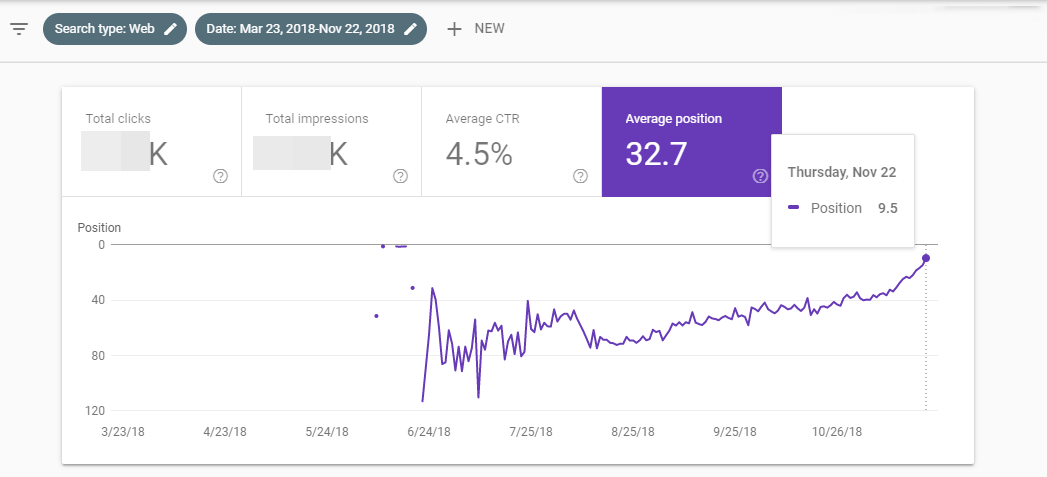
Google Sandbox is a commonly believed filter that’s used by Google to prevent new websites from ranking high in Google’s Search Engine Results Pages (SERPs). It’s believed that Google uses this filter to put some restrictions on rankings for new websites.
The main idea behind it is that new websites may not be as relevant as the old ones. Moreover, some of them may even be spam.
While Google has never confirmed the existence of such a system, many SEOs believe that it exists. They claim so because they have seen such effects on websites that they are trying to rank. This is why it is extremely difficult to avoid being placed in the Google Sandbox when your domain is new.
So, does Google Sandbox still exist in 2019? If it still does, how do you avoid getting affected by it? Let’s take a deeper look into it.
The history of Google Sandbox
In 2004, a lot of SEOs found that their new websites weren’t ranking well on Google during their first few months. And this happened in spite of the best of their efforts. While their websites were easily indexed by Google, they weren’t able to rank well for even low-competition keywords. On the flip side, they were ranking well on other search engines such as Yahoo and Bing.
This effect of Google Sandbox lasted for several weeks and months and it varied for each website. The idea of such a system made sense because Google aimed to provide only the most authoritative and quality content to its users. Rand Fishkin from Moz believed that SEOmoz was in Google Sandbox for about nine months. This happened in spite of having a good backlink profile.
“SEOmoz is finally Sandbox free for the first time since our move to this domain nine months ago. We aren’t alone, either. Many folks had sites escape, and I’m happy for all of them. It looks like our 12,000+ all‐natural links (never link built for this site, just link‐baited) finally paid off.”
Rand Fishkin, Co‐founder Moz
In 2014, yet again, Google Sandbox caught the interest of SEOs and marketers when they saw that their new websites weren’t able to rank easily. Now that we know a brief history of Google Sandbox and what it can do, let’s look at how it is working in 2019.
What does Google say about Google Sandbox?
Google pretty much denies the existence of this Sandbox. In fact, you can see it through many tweets by Google’s employees.

Source: Twitter
Even a Webmaster Trends Analyst at Google said the same thing –
“With regards to sandbox, we don’t really have this traditional sandbox that a lot of SEOs used to be talking about in the years past. We have a number of algorithms that might look similar, but these are essentially just algorithms trying to understand how the website fits in with the rest of the websites trying to rank for those queries. […] It’s always kind of tricky in the beginning when we have a new website and we don’t quite know where we should put it.”
– John Mueller
However, the former head of webspam at Google did end up giving a few hints about it.
“My answer is not to worry that much. The difference between a domain that’s six months old versus one-year-old is really not that big at all. So as long as you’ve been around for a least a couple months, a few months, you should be able to make sure that you’re able to show up in the search results.”
– Matt Cutts
Why does a new website not rank high on Google?
Google’s experts have mentioned that they need enough data to rank a site. A new website must show its expertise, authoritativeness, and trustworthiness to Google. Additionally, it should have a good backlink profile. However, it is very unlikely that a new website can win Google’s trust within a very short period of time.
Here are a few reasons why a new website may not rank high on Google.
1. Less content
To understand your website’s relevance to a certain topic, Google needs to go through your website’s pages. If your website doesn’t have enough content on it, Google may not be able to fully understand what your website is meant for.
2. Low on backlinks
Backlinks are one of the most important factors for ranking a website on Google. If your website has a weak backlink profile, Google may not rank it higher up in searches. Moreover, your website should have internal links that can allow link juice to pass through them. You might succeed in building loads of backlinks in a very short period of time but if they are not of high quality, Google may just ignore them.
You must also be very careful as rapidly grown backlink profiles may even give you penalties from Google.
3. Lesser user signals
Google may take time to analyze the behavioral data of your website visitors. For this reason, it may postpone ranking your website higher up in search results for popular keywords. It’ll observe things like click-through rate, dwell time, and bounce rate to see if your website is worthy of ranking higher up.
Now that you know why your website could be in the Google Sandbox, let’s figure out how you can get out of it quickly.
Is Google Sandbox still affecting sites in 2019?
There are many SEOs out there who claim that their website ranks high up in the search results within just a month of launching. On the other hand, there are other SEOs who believe that there is definitely some force that is stopping their websites from ranking in the search results during their first few months.
However, through our study, we found that even a new website can rank higher up in searches within a short time period. We launched our blog website in June 2018 and within just four months we managed to reach the first page of search results. As you can see in the screenshot, there is a huge fluctuation in the average position graph. This was the time when Google started collecting data about our website. You can notice from the chart that after two months, there was a consistent increase in the rankings. We got the 9.5 average position for the whole site in Google Search Console.

We also ranked a few other sites with higher volume keywords in less than six months. So, according to our research, Google Sandbox is a myth. With consistent efforts, you can rank high up in SERPs in a short duration.
What did we find during our study?
My own theory is almost the same as Google says. Google Sandbox doesn’t exist according to me. It could be possible that Google doesn’t prefer to rank new sites but it doesn’t mean that a new site can’t rank higher. Google wants to rank trusted and useful content. But for a new site, Google doesn’t have the required information to rank it. As soon as you are able to show to Google that you are genuine and trustworthy, you will start ranking higher.
I found that the ranking of a new site depends on its niche, competition, and your SEO strategy. These are the most important factors, according to me. For example, one of our sites started ranking with only social signals. It was a modeling niche site. We didn’t focus on link building for that site. We were just sharing its content on social media. In just a few weeks, keywords started ranking on the first page. Some higher competitive keywords were not ranking.
Rest of it depends upon your SEO strategy. Are you focusing on branding or rankings?
Let me explain, if you’re focusing on acquiring more links, it means you want rankings. But if you want links from top-tier high authority sites, means you are trying to build a brand. And Google loves brands. These days, Google is working for the future. SEO-friendly content and more backlinks are not enough to rank your website. You should focus on branding if you want to rank in a short time and for the long term. Try to get exposure, create online buzz, brand searches, and user satisfaction.
How to rank higher quickly?
While Google Sandbox can be annoying for new websites, there are methods you can use to get out of it quickly.
Here are a few things you can do:
1. Get your website indexed quickly
Your website may have already gone live, however, it doesn’t start aging in the eyes of Google unless it is actually indexed by it. To check if your website has been indexed by Google, you simply need to do a Google search. Just type “site:yourdomain.com” to check how many pages of your website have been indexed by Google.
If it has not been indexed yet, you need to get it done as soon as possible. To speed up the process, you can register the domain on Google Search Console and submit your XML sitemap.
2. Traffic
Getting traffic to your website is very important, especially in its early days. It is one factor that can help your website rank higher up and get out of Google Sandbox quickly. To get more visitors to your website, you should consider posting regularly in forums and groups on Facebook.
You can even try guest posting on other popular websites to drive traffic to your website and at the same time build a stronger backlink profile. You may also run ads on Facebook and other social media platforms to drive traffic.
3. Social signals
Social signals are important to gain the trust of Google because they indicate that your website is gaining popularity on social media platforms. A great way of using social signals to your advantage is that of running Facebook ads. You can publish an article on your blog and then run Facebook ads to drive traffic to it.
4. Choose long tail keywords
Google may not give you much traction for popular keywords earlier on when you are in the perceived Sandbox. However, you may be able to rank well for long tail keywords. To do this, you will first need to do keyword research and check the competition for every long tail keyword that you intend to target. You can use tools such as Ubersuggest and SEMrush to do this.
It is also a good idea to conduct competitor research and go after the keywords that they are ranking for. Using tools such as SEMrush, you can conduct competitor research by simply entering the URL of your competitor.
5. Build authority
“Google Shows Popular, Google doesn’t make you popular” – Google
Google wants authoritative, trustworthy, and user-friendly content to rank on top. As a new site, Google doesn’t know much about you because they don’t have enough data about your website.
So you should build authority and trust in the eyes of Google and users. Google will trust you if your site has good user-metrics, links, mentions from high-authority and relevant sites, and brand queries for your site. You should build more authority for your site.
6. Don’t be too aggressive
Focus on quality than quantity.
You may want to see your website high up in the SERPs. However, if you become too aggressive in promoting your website and link building, Google may see it as spam. You should try to acquire premium links for your new site. Only a few but premium links can change the picture.
Ideally, you shouldn’t build a huge number of links in a short period of time. Moreover, you should drip-feed the foundational links that you’ve built. Don’t optimize your anchor text too much, it’s preferable to keep it under-optimized. Lastly, make sure that you get good enough social signals.
It’s a good idea to give your website a slow and steady start. This will help it grow and prosper in the long run and will help in building more trust with Google. Once Google trusts you more, you can become slightly more aggressive in your link building methods.
7. Purchase an active website
One of the easiest ways of avoiding Google Sandbox is that of purchasing a website that is already active. You can do so by spending a decent sum of money on a website that has decent traffic and has been online for quite some time but has hardly any income.
Using tools such as Flippa, you can find websites which are already active and then can purchase and repurpose them to fit your requirements. Moreover, purchasing an already active website can help you figure out the power that the domain has by checking which keywords the website already ranks for.
Final thoughts
What do you think about Google Sandbox and what is the best way of getting out of the Google Sandbox? Let us know in the comments.
Harpreet Munjal is the founder of the digital marketing company, LoudGrowth. He can be found on Twitter .
Related reading
Flushing money into advertising without understanding its workflow is not cool. Top hacks every advertiser should use to improve Google Ads performance.
Traffic forecasting is one of a CMO’s best resources to allocate marketing spend across the most useful tactics. Here’s how traffic forecasting could mean smarter ad spend.
FAQs improve SEO rankings as Google values your website for providing all the information needed to take an educated decision. Five ways to get it right.





